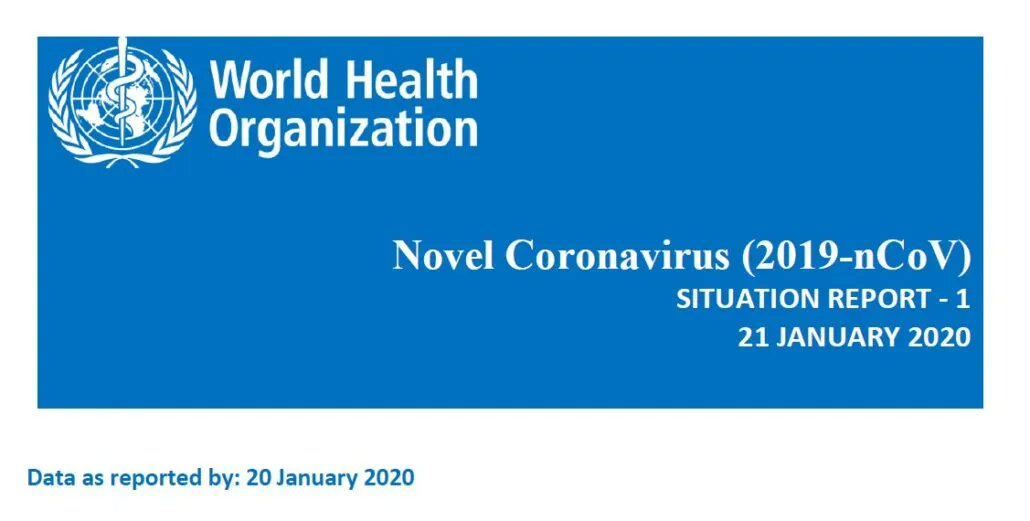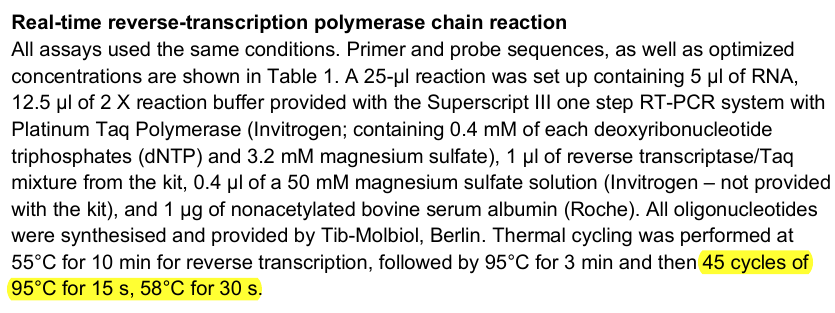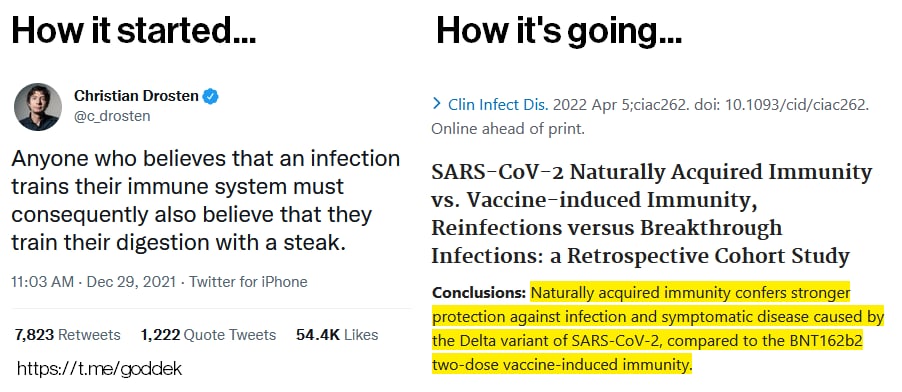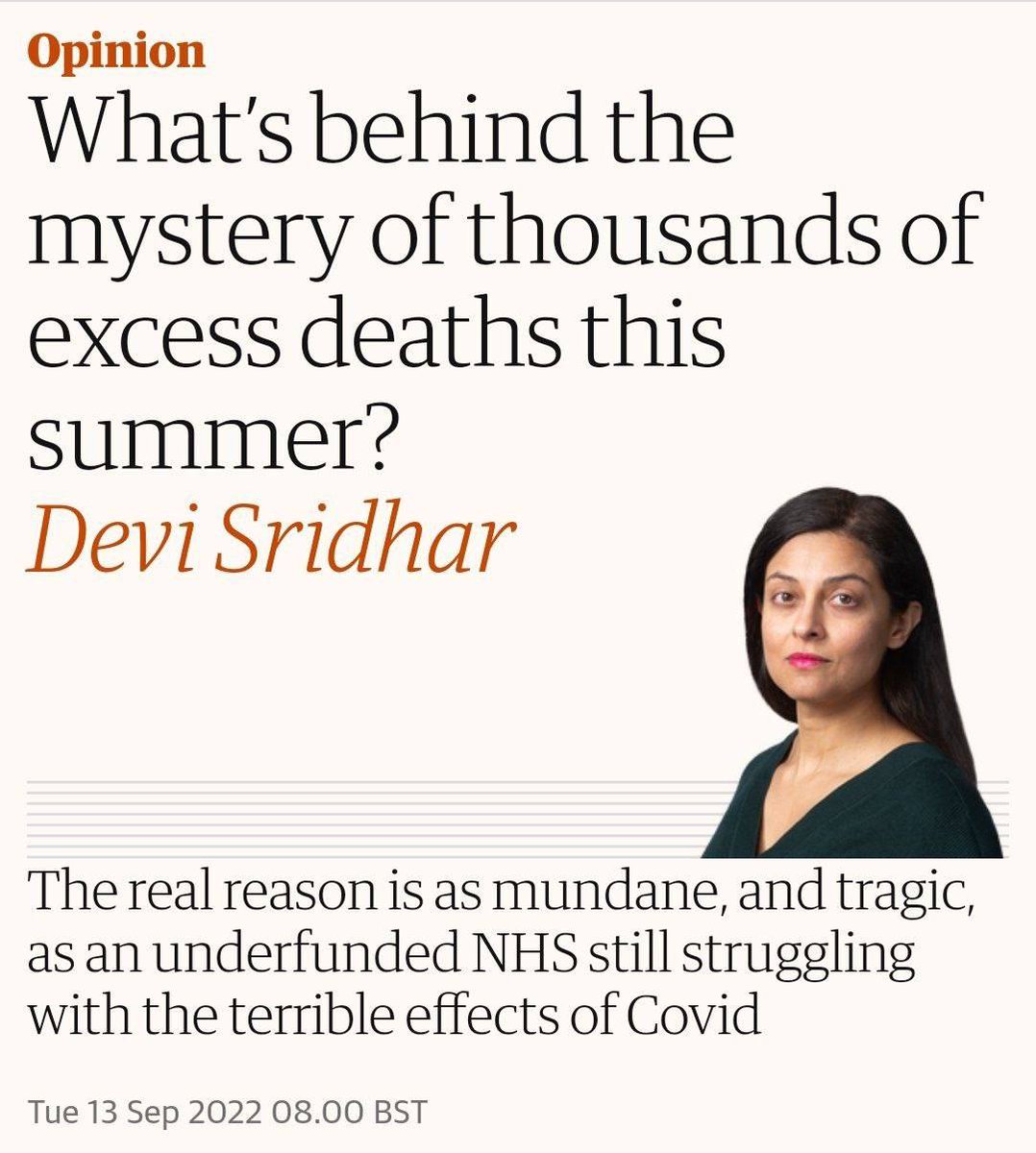
1/ Two years ago, @c_drosten published a paper on the Covid PCR test in the journal @eurosurveillanc where he is a member of the editorial board. That article formed the basis for the current global agenda.
In this 𝙏𝙃𝙍𝙀𝘼𝘿, I will explain this scandal of epic proportions.
In this 𝙏𝙃𝙍𝙀𝘼𝘿, I will explain this scandal of epic proportions.

2/ As a former Editor of a Scientific Journal, I will give you some more insights into scientific peer-review processes and why fraudulent manipulation concerning Drosten’s PCR paper most likely took place in the Journal of publication @Eurosurveillanc. eurosurveillance.org/content/10.280…
3/ The paper set out principles concerning the PCR testing procedure and is therefore considered critically. An international consortium of experts and scientists have critically analysed this mentioned publication and have found several serious flaws. cormandrostenreview.com/report/
4/ These flaws, however, are mainly but not entirely of contentual nature. Unfortunately, until now, 36 months later, the Journal and the involved authors failed to come up with counterarguments and explanations.
5/ Instead, the journal “decided that the criteria for a retraction of the article have not been fulfilled.” What keeps me puzzled is that they do not want to make these peer-review reports publicly due to privacy reasons, but they are always anonymous.
eurosurveillance.org/content/10.280…
eurosurveillance.org/content/10.280…
6/ In addition to the substantive and conceptual weaknesses of the paper, what worries me the most is how fundamental scientific principles have been compromised by the Journal @Eurosurveillanc.
7/ The graphic below shows the duration of the Journal’s peer-review process (h/t @waukema). In 2019, the average time to publication for “original research papers” was 172 days, which aligns with my personal experiences. So how is it possible to publish a paper within hours? 

8/ Let's take a closer look at how the 𝗽𝗲𝗲𝗿-𝗿𝗲𝘃𝗶𝗲𝘄 process works: After writing the paper, the corresponding author (in this case @c_drosten) had to submit the article via a submission form that looks as follows. “Agreement with authors” is another required document. 

9/ Christian Drosten consequently had to confirm that there were no conflicts of interest. Yet, @c_drosten was not honest as several (!!!) conflicts of interest were detected that eventually were corrected under pressure at the end of July 2020. 

10/ After the paper submission, the Editor-in-chief (i.e. Dr Ines Steffens) had to accept the paper for peer review. One can argue that Drosten as an editorial board member, might have had good relationships with that lady that could have accelerated the process. Point taken!
11/ The manuscript then had to be sent to at least two external and unbiased reviewers by either the Editor-in-chief or other editors of the editorial team. I am usually happy to find sufficient peer-reviewers within 1-2 weeks (best case scenario). eurosurveillance.org/about
12/ Once an external peer reviewer, who needs to be an expert in that field, accepts the task to review, they generally have 30 days to perform the job. Reviewing a paper properly usually is not done within one day. It occurs very rarely that a review is completed within days.
13/ Each reviewer then has to rate the paper. There are usually four recommendations the reviewers can give:
1. Reject [most common]
2. Major Revisions [common]
3. Minor Revisions [rather uncommon]
4. Accept [extremely rare]
1. Reject [most common]
2. Major Revisions [common]
3. Minor Revisions [rather uncommon]
4. Accept [extremely rare]
14/ After both reviewers have given their recommendations, this is what the editor sees as soon as the peer review process is complete. You can see the dates on the left side, which is a good indicator of how long a “first round” usually takes. 

15/ In the case above (example from my former Journal), both reviewers propose major revisions to the manuscript. If the editor agrees with this recommendation, the authors receive the reviewers’ comments that must be addressed before entering the iteration processes.
16/ My experience is as follows:
▶︎ Having two reviewers immediately accept the manuscript is close to impossible (given the methodological flaws, I cannot imagine such a scenario)
▶︎ It usually takes 2-4 review iterations until a publication can be considered publishable
▶︎ Having two reviewers immediately accept the manuscript is close to impossible (given the methodological flaws, I cannot imagine such a scenario)
▶︎ It usually takes 2-4 review iterations until a publication can be considered publishable
17/ Having a paper accepted within 24h would consequently mean that:
1. The editor in charge found experts that are willing to review within hours
2. All experts immediately reviewed the manuscript and found it “perfect as it is”
3. The editor directly handled the review reports
1. The editor in charge found experts that are willing to review within hours
2. All experts immediately reviewed the manuscript and found it “perfect as it is”
3. The editor directly handled the review reports
18/ However, after acceptance (see screenshot example), the paper still needs to be sent to a typesetter so that the manuscript is in the style (i.e. formatting, citation style etc.) of the Journal. This usually takes several days up to two weeks. 

19/ The typesetter then returns to the corresponding author with “Queries” (i.e. Q1-Qx). These queries usually address internal (tables, figures) and external (cited work) references and co-author details. All queries need to be addressed by the corresponding author.
20/ After addressing all queries, it usually takes more days to make the publication available online in its final form. This whole procedure from submission to publication takes about six months on average, which would be in line with the journal’s usual paper processing times.
21/ Less than one day, however, smells like scientific fraud and corruption. By the time of submission, extraordinary importance was no factor that could explain this phenomenon. This is a major scientific scandal, and @Eurosurveillanc wraps itself in silence.
22/ The fact that Drosten’s procedure follows a similar script compared with the swine flu “pandemic” in 2009 (i.e. collaboration with Olfert Landt concerning the PCR test creation, scaremongering etc.) leaves a sour aftertaste. ncbi.nlm.nih.gov/pmc/articles/P…
23/ This scandal needs to be fully clarified, especially concerning the roles of all individuals and parties involved (e.g. Drosten and Steffens). I wonder why co-authors such as @MarionKoopmans didn’t find it suspicious that their paper was literally available online overnight.
24/ As a co-author, I would immediately express my concerns. The whole situation becomes even more obscure, knowing that Koopmans was part of a WHO panel that declared Drosten’s PCR test “gold standard” one day after the paper was published, which means two days after submission.
25/ That paper has set off an avalanche and has been cited more than 7000 times within three years. But unfortunately, the work and its publication process do not meet any requirement of scientific accuracy and formal correctness. 

26/ The publication thus needs to be marked as biased by @Eurosurveillanc immediately. In addition, an independent commission needs to examine the exact process and possible fraud/corruption (back in January 2020) and come up with possible consequences for all parties involved.
@Eurosurveillanc 27/ I want to state that I did not intend to set off an avalanche in January 2021. I simply could not believe my eyes when I saw how quickly Drosten’s publication got peer-reviewed and published. As a scientist, it is my right and duty to address this and raise questions. 

@Eurosurveillanc 28/ Right after my first Twitter thread on that topic went viral, I was warned by several people that I needed to be prepared for “Drosten’s army” to attack me. Something I could not have imagined, as I have never received any shitstorm on the internet before.
@Eurosurveillanc 29/ It is hard to describe complex issues with only 280 characters, making misunderstandings and conflicts virtually inevitable. Over time, the perceived personal view or conviction might change due to the latest state of knowledge or varying contexts.
@Eurosurveillanc 30/ The sad fact is that none of the attackers was dealing with what I had written. Many of them were linked to Drosten himself, addressed Springer Nature directly, and demanded my withdrawal as an editor in the field of aquaponics, as I am “hardly a specialist in virology”.
@Eurosurveillanc 31/ However, I didn't address the topic of virology in my thread but solely gave insights into the peer-review process. My precise analysis showed that the actual window for the peer-review process was 3.5-27.5 hours, which I will elaborate on below. It eventually cost me my job.
@Eurosurveillanc 32/ Everything goes back to a document of the WHO, which was created (!!!) the day the Corman-Drosten paper was submitted to @Eurosurveillanc. The meta-data shows that it was created on the 21st of January 2020 at 8:30 pm CET (Central European Time). 



@Eurosurveillanc 33/ Via the Wayback Machine, everybody can download the first version of the paper published on the Eurosurveillance server. This paper cites the WHO document below (marked in green). 

@Eurosurveillanc 34/ The Drosten paper was officially submitted on 21/01/2020, accepted on 22/01/2020, and published on 23/01/2020. This means that, given the timestamp of the WHO paper, there is only a 3.5h theoretical time window that the paper could have been submitted on 21/01/2020. 

@Eurosurveillanc 35/ As stated above, the peer-review process requires quite some time (due to iterations etc.). Given the official data we got, we can retrace how much.
@Eurosurveillanc 36/ So the earliest moment the paper could have been peer-reviewed and accepted is on 22/01/20 at midnight and the latest on 22/01/20 at 11:59 pm (CET). The whole peer-review process thus had a time window of 3.5h-27.5h. 

@Eurosurveillanc 37/ The paper was published on 23/01/20 at 4:45 pm (CET), so the typesetter did a fantastic job. Again, this is just my humble analysis of this process that I am willing to share, and I am also ready to discuss my findings critically.
@Eurosurveillanc 38/ Theoretically speaking, the reference to the WHO document could have been modified during the typesetter’s “query process”, expanding the time window by some hours. Nonetheless, the observed and reconstructed peer-review process shows considerable irregularities.
@Eurosurveillanc 39/ Every peer-review process leads to anonymous review reports. When demanding Eurosurveillance at least release these reports they said they could not do so due to privacy concerns. However, all peer-review reports are anonymous, so they lied there to cover up scientific fraud.
@Eurosurveillanc 40/ Even a possible “extraordinary importance” (which was not a factor back in January 2020) is no reason to rush through the process that quickly. The publication could also have been made available as a pre-print document while undergoing a thorough peer-review process.
41/ All things considered, transparency is required in this critical case. And again: it is discourteous to shoot the messenger when criticism would be better addressed to the parties involved in these apparent irregularities.
42/ After three years, the journal is still shrouded in silence. The scandal has still not been dealt with transparently. Nor has any legal action been taken against @c_drosten or @Eurosurveillanc.
@c_drosten @Eurosurveillanc 43/ As mentioned above, @MarionKoopmans was part of the @WHO panel that declared @c_drosten’s test as “gold standard” one day after the publication of that paper. So, let us take a look at the bigger picture of this scandal. (h/t @RemnantMD) 

@c_drosten @Eurosurveillanc @MarionKoopmans @WHO @RemnantMd 44/ So @c_drosten developed this PCR test in collaboration with his buddy Olfert Landt (also co-author of that paper) who owned the PCR kit manufacturing company TIB MolBiol. He sold his company to @Roche in September 2021. pharmanewsintel.com/news/roche-acq…
@c_drosten @Eurosurveillanc @MarionKoopmans @WHO @RemnantMd @Roche 45/ This test was implemented by a lab in Slovenia on January 17th, 2020, even though Olfert Landt created that document on January 15th. The lab stated that the test was “extensively tested” by then which indicates that it has been available for much longer; maybe even in 2019. 

@c_drosten @Eurosurveillanc @MarionKoopmans @WHO @RemnantMd @Roche 46/ Originally, the test’s cycle threshold was set to 30. However, the PCR protocol that drosten submitted to the WHO on January 17th, shows a ct-value of 45, which is ridiculously high. This is how you create a plandemic. 



@c_drosten @Eurosurveillanc @MarionKoopmans @WHO @RemnantMd @Roche 47/ Summed up:
▶︎ Drosten submits PCR protocol to the @WHO
▶︎ WHO sends the PCR protocol to countries around the world
▶︎ Countries test population using this protocol
▶︎ As dictated by the International Health Regulations, positive results had to be submitted to the WHO
▶︎ Drosten submits PCR protocol to the @WHO
▶︎ WHO sends the PCR protocol to countries around the world
▶︎ Countries test population using this protocol
▶︎ As dictated by the International Health Regulations, positive results had to be submitted to the WHO
@c_drosten @Eurosurveillanc @MarionKoopmans @WHO @RemnantMd @Roche 48/ All of this couldn’t have been done without that rapid peer review process. Back then, there was no imminent danger of any pathogen. Even @c_drosten said that one should not be worried until February and March 2020. So why that hurry? We all know why.
@c_drosten @Eurosurveillanc @MarionKoopmans @WHO @RemnantMd @Roche 49/ What we have learned is that @c_drosten...
▶︎ Created that specific PCR test most likely even before the outbreak of the pandemic
He even...
▶︎ Denied viral seasonality (t.me/goddek/1295)
▶︎ Made contradictory statements about masks (t.me/goddek/563)
▶︎ Created that specific PCR test most likely even before the outbreak of the pandemic
He even...
▶︎ Denied viral seasonality (t.me/goddek/1295)
▶︎ Made contradictory statements about masks (t.me/goddek/563)
@c_drosten @Eurosurveillanc @MarionKoopmans @WHO @RemnantMd @Roche 50/ He also...
▶︎ Predicted piles of corpses on African streets (bit.ly/3ictjy4)
▶︎ Called @DrJBhattacharya a "pseudoscientist" (bit.ly/36ngzle)
▶︎ Got funds from the @gatesfoundation and had his professorship sponsored by Nazi-money (Quandt Family)
▶︎ Predicted piles of corpses on African streets (bit.ly/3ictjy4)
▶︎ Called @DrJBhattacharya a "pseudoscientist" (bit.ly/36ngzle)
▶︎ Got funds from the @gatesfoundation and had his professorship sponsored by Nazi-money (Quandt Family)
@c_drosten @Eurosurveillanc @MarionKoopmans @WHO @RemnantMd @Roche @DrJBhattacharya @gatesfoundation 51/ Questions still remaining unanswered:
▶︎ How did the paper make it through the peer review process within 24h?
▶︎ How does he even publish there while being part of the journal's editorial board?
▶︎ Why does the journal refuse to publish anonymous peer-review reports?
▶︎ How did the paper make it through the peer review process within 24h?
▶︎ How does he even publish there while being part of the journal's editorial board?
▶︎ Why does the journal refuse to publish anonymous peer-review reports?
@c_drosten @Eurosurveillanc @MarionKoopmans @WHO @RemnantMd @Roche @DrJBhattacharya @gatesfoundation 52/ Things have been quiet around Christian Drosten in recent months after drawing weird comparisons. For the most part, he withdrew from the public eye (besides today's podcast to advertise vaccines), or as I would say, the rats are deserting the sinking ship. 

@c_drosten @Eurosurveillanc @MarionKoopmans @WHO @RemnantMd @Roche @DrJBhattacharya @gatesfoundation 53/ Recently, however, he gave a comprehensive interview to the German newspaper Die ZEIT, peppered with untruths. I have done the work to translate this interview in part and to document the extent to which Drosten lied.
drsimon.substack.com/p/christian-dr…
drsimon.substack.com/p/christian-dr…
@c_drosten @Eurosurveillanc @MarionKoopmans @WHO @RemnantMd @Roche @DrJBhattacharya @gatesfoundation 54/ Wrapping this thread up we can summarize that:
▶︎ Drosten had the network. “WHO for the panic and Olfert together with the large corporation for the kits.
▶︎ Fun fact, Eurosurveillance’s impact factor increased from 6.5 in 2019, to 21 in 2021.
▶︎ Drosten had the network. “WHO for the panic and Olfert together with the large corporation for the kits.
▶︎ Fun fact, Eurosurveillance’s impact factor increased from 6.5 in 2019, to 21 in 2021.
@c_drosten @Eurosurveillanc @MarionKoopmans @WHO @RemnantMd @Roche @DrJBhattacharya @gatesfoundation 55/ Also timing plays a role. Without this PCR test, there would have been neither a "diagnosis" nor a "dashboard" in early January.
@c_drosten @Eurosurveillanc @MarionKoopmans @WHO @RemnantMd @Roche @DrJBhattacharya @gatesfoundation 56/ I do not believe this fraud will be solved, which has allowed taking the whole world hostage, but I do not give up hope. The more people know about this fraud, the more likely it is that something like “justice” will arrive one day. 

@c_drosten @Eurosurveillanc @MarionKoopmans @WHO @RemnantMd @Roche @DrJBhattacharya @gatesfoundation 57/ The fact that Drosten has largely withdrawn from the public eye is also an indication that he would prefer to be forgotten. But we should never forget. This person belongs on trial. Thanks for sharing this thread.
@c_drosten @Eurosurveillanc @MarionKoopmans @WHO @RemnantMd @Roche @DrJBhattacharya @gatesfoundation 58/ I also want to take the opportunity to thank a few people who have supported me in writing this thread. Thank you @spasskultur, @naomirwolf, @vigilantfox, @DrLoupis, @RealJermWarfare, @KanekoaTheGreat, @TheChiefNerd, and @LynnFynn3. Please give them a warm follow.
@c_drosten @Eurosurveillanc @MarionKoopmans @WHO @RemnantMd @Roche @DrJBhattacharya @gatesfoundation @spasskultur @naomirwolf @VigilantFox @DrLoupis @RealJermWarfare @KanekoaTheGreat @TheChiefNerd @LynnFynn3 59/ You can also read a quick summary of this mega-thread on my substack channel. If you like my content, please subscribe to my newsletter there. drsimon.substack.com/publish/post/7…
@c_drosten @Eurosurveillanc @MarionKoopmans @WHO @RemnantMd @Roche @DrJBhattacharya @gatesfoundation @spasskultur @naomirwolf @VigilantFox @DrLoupis @RealJermWarfare @KanekoaTheGreat @TheChiefNerd @LynnFynn3 60/ Did you know that less than 10% of my posts make it to your Twitter feed? If you appreciate my posts and don't want to miss anything, consider hitting the bell on my profile page: @goddeketal 

@c_drosten @Eurosurveillanc @MarionKoopmans @WHO @RemnantMd @Roche @DrJBhattacharya @gatesfoundation @spasskultur @naomirwolf @VigilantFox @DrLoupis @RealJermWarfare @KanekoaTheGreat @TheChiefNerd @LynnFynn3 61/ Bonus Material #1
1.) Drosten is saying that vaccines do prevent from getting sick.
2.) Drosten consequently lies about "vaccination immunity".
3.) Drosten lied about the statement that we could overcome the pandemic by mass vaccination.
1.) Drosten is saying that vaccines do prevent from getting sick.
2.) Drosten consequently lies about "vaccination immunity".
3.) Drosten lied about the statement that we could overcome the pandemic by mass vaccination.
@c_drosten @Eurosurveillanc @MarionKoopmans @WHO @RemnantMd @Roche @DrJBhattacharya @gatesfoundation @spasskultur @naomirwolf @VigilantFox @DrLoupis @RealJermWarfare @KanekoaTheGreat @TheChiefNerd @LynnFynn3 62/ Bonus Material #2
“Don’t trust any professors or doctors that claim to have a clue about these things just because they are MDs.”
“Don’t trust any professors or doctors that claim to have a clue about these things just because they are MDs.”
@c_drosten @Eurosurveillanc @MarionKoopmans @WHO @RemnantMd @Roche @DrJBhattacharya @gatesfoundation @spasskultur @naomirwolf @VigilantFox @DrLoupis @RealJermWarfare @KanekoaTheGreat @TheChiefNerd @LynnFynn3 63/ Correction: of course, it was THREE years ago. It's crazy how time flies.
https://twitter.com/goddeketal/status/1613619120313962498
@c_drosten @Eurosurveillanc @MarionKoopmans @WHO @RemnantMd @Roche @DrJBhattacharya @gatesfoundation @spasskultur @naomirwolf @VigilantFox @DrLoupis @RealJermWarfare @KanekoaTheGreat @TheChiefNerd @LynnFynn3 64/ And we should not forget about @StephenABustin. He testified against Wakefield for $500K, criticizing Wakefield for the same mistakes that exist in Drosten's approach. He claims to be one of the reviewers for the CD report.
https://twitter.com/Kevin_McKernan/status/1359345102569811969
• • •
Missing some Tweet in this thread? You can try to
force a refresh












